1. Berger RA. The anatomy of the ligaments of the wrist and distal radioulnar joints. Clin Orthop Relat Res. 2001; (383):32–40.

2. Mayfield JK, Johnson RP, Kilcoyne RK. Carpal dislocations: pathomechanics and progressive perilunar instability. J Hand Surg Am. 1980; 5:226–41.

3. Kozin SH. Perilunate injuries: diagnosis and treatment. J Am Acad Orthop Surg. 1998; 6:114–20.

4. Muppavarapu RC, Capo JT. Perilunate dislocations and fracture dislocations. Hand Clin. 2015; 31:399–408.

5. Grabow RJ, Catalano L 3rd. Carpal dislocations. Hand Clin. 2006; 22:485–500.

6. Inoue G, Shionoya K. Late treatment of unreduced perilunate dislocations. J Hand Surg Br. 1999; 24:221–5.

7. Komurcu M, Kürklü M, Ozturan KE, Mahirogullari M, Basbozkurt M. Early and delayed treatment of dorsal transscaphoid perilunate fracture-dislocations. J Orthop Trauma. 2008; 22:535–40.

8. Green DP, O’Brien ET. Open reduction of carpal dislocations: indications and operative techniques. J Hand Surg Am. 1978; 3:250–65.

9. Bathala EA, Murray PM. Long-term follow-up of an undiagnosed trans-scaphoid perilunate dislocation demonstrating articular remodeling and functional adaptation. J Hand Surg Am. 2007; 32:1020–3.

10. Bagheri F, Taraz-Jamshidi MH, Birjandinejad A, et al. Trans-scaphoid perilunate fracture-dislocation and isolated perilunate dislocations; surgical versus non surgical treatment. Arch Bone Jt Surg. 2013; 1:74–7.
11. Herzberg G, Comtet JJ, Linscheid RL, Amadio PC, Cooney WP, Stalder J. Perilunate dislocations and fracture-dislocations: a multicenter study. J Hand Surg Am. 1993; 18:768–79.

12. Sochart DH, Birdsall PD, Paul AS. Perilunate fracture-dislocation: a continually missed injury. J Accid Emerg Med. 1996; 13:213–6.

13. Craigen MA, Stanley JK. Wrist kinematics: row, column or both? J Hand Surg Br. 1995; 20:165–70.
14. Moritomo H, Apergis EP, Herzberg G, Werner FW, Wolfe SW, Garcia-Elias M. 2007 IFSSH committee report of wrist biomechanics committee: biomechanics of the so-called dart-throwing motion of the wrist. J Hand Surg Am. 2007; 32:1447–53.

15. Rainbow MJ, Kamal RN, Leventhal E, et al. In vivo kinematics of the scaphoid, lunate, capitate, and third metacarpal in extreme wrist flexion and extension. J Hand Surg Am. 2013; 38:278–88.

16. Rainbow MJ, Wolff AL, Crisco JJ, Wolfe SW. Functional kinematics of the wrist. J Hand Surg Eur Vol. 2016; 41:7–21.

17. Mayfield JK, Johnson RP, Kilcoyne RF. The ligaments of the human wrist and their functional significance. Anat Rec. 1976; 186:417–28.

18. Herzberg G, Burnier M, Marc A, Merlini L, Izem Y. The role of arthroscopy for treatment of perilunate injuries. J Wrist Surg. 2015; 4:101–9.
19. Katz DA, Green JK, Werner FW, Loftus JB. Capsuloligamentous restraints to dorsal and palmar carpal translation. J Hand Surg Am. 2003; 28:610–3.

20. Scalcione LR, Gimber LH, Ho AM, Johnston SS, Sheppard JE, Taljanovic MS. Spectrum of carpal dislocations and fracture-dislocations: imaging and management. AJR Am J Roentgenol. 2014; 203:541–50.

21. Buijze GA, Lozano-Calderon SA, Strackee SD, Blankevoort L, Jupiter JB. Osseous and ligamentous scaphoid anatomy: Part I. A systematic literature review highlighting controversies. J Hand Surg Am. 2011; 36:1926–35.

22. Ritt MJ, Stuart PR, Berglund LJ, Linscheid RL, Cooney WP 3rd, An KN. Rotational stability of the carpus relative to the forearm. J Hand Surg Am. 1995; 20:305–11.

23. Viegas SF, Patterson RM, Ward K. Extrinsic wrist ligaments in the pathomechanics of ulnar translation instability. J Hand Surg Am. 1995; 20:312–8.

24. Berger RA, Blair WF. The radioscapholunate ligament: a gross and histologic description. Anat Rec. 1984; 210:393–405.

25. Berger RA. The ligaments of the wrist: a current overview of anatomy with considerations of their potential functions. Hand Clin. 1997; 13:63–82.
26. Short WH, Werner FW, Green JK, Sutton LG, Brutus JP. Biomechanical evaluation of the ligamentous stabilizers of the scaphoid and lunate: part III. J Hand Surg Am. 2007; 32:297–309.

27. Sennwald GR, Zdravkovic V, Kern HP, Jacob HA. Kinematics of the wrist and its ligaments. J Hand Surg Am. 1993; 18:805–14.

28. Montero Lopez NM, Paksima N. Perilunate injuries and dislocations etiology, diagnosis, and management. Bull Hosp Jt Dis (2013). 2018; 76:33–7.
29. Berger RA, Imeada T, Berglund L, An KN. Constraint and material properties of the subregions of the scapholunate interosseous ligament. J Hand Surg Am. 1999; 24:953–62.

30. Ritt MJ, Bishop AT, Berger RA, Linscheid RL, Berglund LJ, An KN. Lunotriquetral ligament properties: a comparison of three anatomic subregions. J Hand Surg Am. 1998; 23:425–31.

31. Trumble TE, Bour CJ, Smith RJ, Glisson RR. Kinematics of the ulnar carpus related to the volar intercalated segment instability pattern. J Hand Surg Am. 1990; 15:384–92.

32. Smith DK. Dorsal carpal ligaments of the wrist: normal appearance on multiplanar reconstructions of three-dimensional Fourier transform MR imaging. AJR Am J Roentgenol. 1993; 161:119–25.

33. Mitsuyasu H, Patterson RM, Shah MA, Buford WL, Iwamoto Y, Viegas SF. The role of the dorsal intercarpal ligament in dynamic and static scapholunate instability. J Hand Surg Am. 2004; 29:279–88.

34. Pulos N, Bozentka DJ. Carpal ligament anatomy and biomechanics. Hand Clin. 2015; 31:381–7.

35. Herzberg G. Acute dorsal trans-scaphoid perilunate dislocations: open reduction and internal fixation. Tech Hand Up Extrem Surg. 2000; 4:2–13.
36. Johnson RP. The acutely injured wrist and its residuals. Clin Orthop Relat Res. 1980; (149):33–44.

37. Yeager BA, Dalinka MK. Radiology of trauma to the wrist: dislocations, fracture dislocations, and instability patterns. Skeletal Radiol. 1985; 13:120–30.

38. Sauder DJ, Athwal GS, Faber KJ, Roth JH. Perilunate injuries. Orthop Clin North Am. 2007; 38:279–88.

39. Adkison JW, Chapman MW. Treatment of acute lunate and perilunate dislocations. Clin Orthop Relat Res. 1982; (164):199–207.

40. Peh WC, Gilula LA. Normal disruption of carpal arcs. J Hand Surg Am. 1996; 21:561–6.

41. Stanbury SJ, Elfar JC. Perilunate dislocation and perilunate fracture-dislocation. J Am Acad Orthop Surg. 2011; 19:554–62.

42. Jones RW. Carpal semilunar dislocations and other wrist dislocations with associated nerve lesions. Proc R Soc Med. 1929; 22:1071–86.

43. Jasmine MS, Packer JW, Edwards GS Jr. Irreducible trans-scaphoid perilunate dislocation. J Hand Surg Am. 1988; 13:212–5.

44. Apergis E, Maris J, Theodoratos G, Pavlakis D, Antoniou N. Perilunate dislocations and fracture-dislocations: closed and early open reduction compared in 28 cases. Acta Orthop Scand Suppl. 1997; 275:55–9.
45. Budoff JE. Treatment of acute lunate and perilunate dislocations. J Hand Surg Am. 2008; 33:1424–32.

46. Krief E, Appy-Fedida B, Rotari V, David E, Mertl P, Maes-Clavier C. Results of perilunate dislocations and perilunate fracture dislocations with a minimum 15-year follow-up. J Hand Surg Am. 2015; 40:2191–7.
47. Chou YC, Hsu YH, Cheng CY, Wu CC. Percutaneous screw and axial Kirschner wire fixation for acute transscaphoid perilunate fracture dislocation. J Hand Surg Am. 2012; 37:715–20.

48. Goodman AD, Harris AP, Gil JA, Park J, Raducha J, Got CJ. Evaluation, management, and outcomes of lunate and perilunate dislocations. Orthopedics. 2019; 42:e1–6.

49. Herzberg G. Perilunate and axial carpal dislocations and fracture-dislocations. J Hand Surg Am. 2008; 33:1659–68.

50. Knoll VD, Allan C, Trumble TE. Trans-scaphoid perilunate fracture dislocations: results of screw fixation of the scaphoid and lunotriquetral repair with a dorsal approach. J Hand Surg Am. 2005; 30:1145–52.

51. Inoue G, Kuwahata Y. Management of acute perilunate dislocations without fracture of the scaphoid. J Hand Surg Br. 1997; 22:647–52.

52. Inoue G, Imaeda T. Management of trans-scaphoid perilunate dislocations: Herbert screw fixation, ligamentous repair and early wrist mobilization. Arch Orthop Trauma Surg. 1997; 116:338–40.
53. Hildebrand KA, Ross DC, Patterson SD, Roth JH, MacDermid JC, King GJ. Dorsal perilunate dislocations and fracture-dislocations: questionnaire, clinical, and radiographic evaluation. J Hand Surg Am. 2000; 25:1069–79.

54. Melone CP Jr, Murphy MS, Raskin KB. Perilunate injuries: repair by dual dorsal and volar approaches. Hand Clin. 2000; 16:439–48.
55. Liu B, Chen SL, Zhu J, Wang ZX, Shen J. Arthroscopically assisted mini-invasive management of perilunate dislocations. J Wrist Surg. 2015; 4:93–100.
56. Park MJ, Ahn JH. Arthroscopically assisted reduction and percutaneous fixation of dorsal perilunate dislocations and fracture-dislocations. Arthroscopy. 2005; 21:1153.

57. Jeon IH, Kim HJ, Min WK, Cho HS, Kim PT. Arthroscopically assisted percutaneous fixation for trans-scaphoid perilunate fracture dislocation. J Hand Surg Eur Vol. 2010; 35:664–8.

58. Kim JP, Lee JS, Park MJ. Arthroscopic reduction and percutaneous fixation of perilunate dislocations and fracture-dislocations. Arthroscopy. 2012; 28:196–203.

59. Liu B, Chen SL, Zhu J, Tian GL. Arthroscopic management of perilunate injuries. Hand Clin. 2017; 33:709–15.

60. Oh WT, Choi YR, Kang HJ, Koh IH, Lim KH. Comparative outcome analysis of arthroscopic-assisted versus open reduction and fixation of trans-scaphoid perilunate fracture dislocations. Arthroscopy. 2017; 33:92–100.

61. Song D, Goodman S, Gilula LA, Wollstein R. Ulnocarpal translation in perilunate dislocations. J Hand Surg Eur Vol. 2009; 34:388–90.

62. Savoie FH 3rd, Grondel RJ. Arthroscopy for carpal instability. Orthop Clin North Am. 1995; 26:731–8.

63. Souer JS, Rutgers M, Andermahr J, Jupiter JB, Ring D. Perilunate fracture-dislocations of the wrist: comparison of temporary screw versus K-wire fixation. J Hand Surg Am. 2007; 32:318–25.

64. Wong TC, Ip FK. Minimally invasive management of trans-scaphoid perilunate fracture-dislocations. Hand Surg. 2008; 13:159–65.





 PDF
PDF Citation
Citation Print
Print



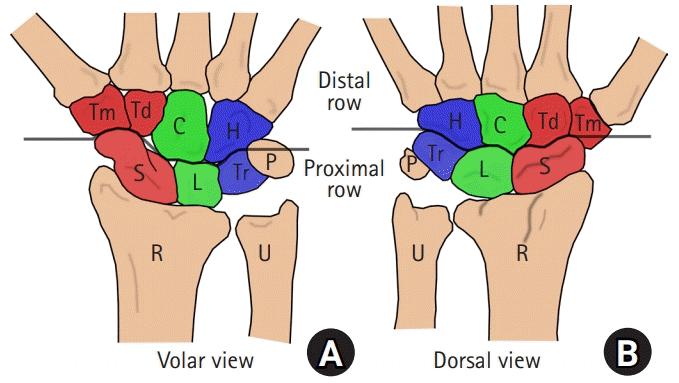
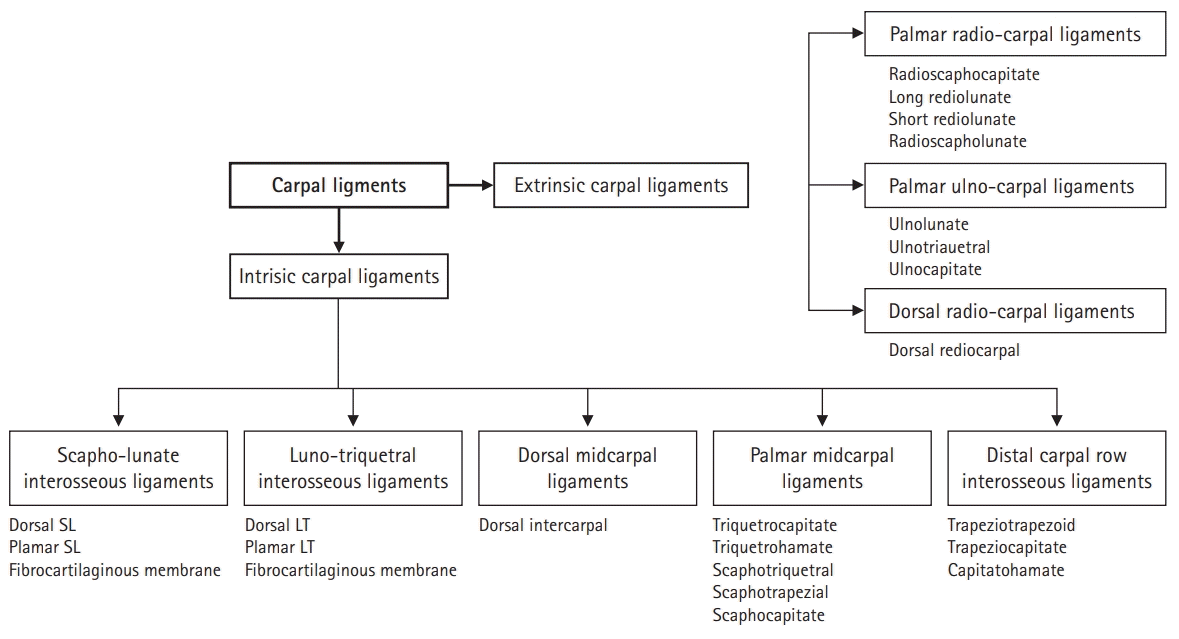
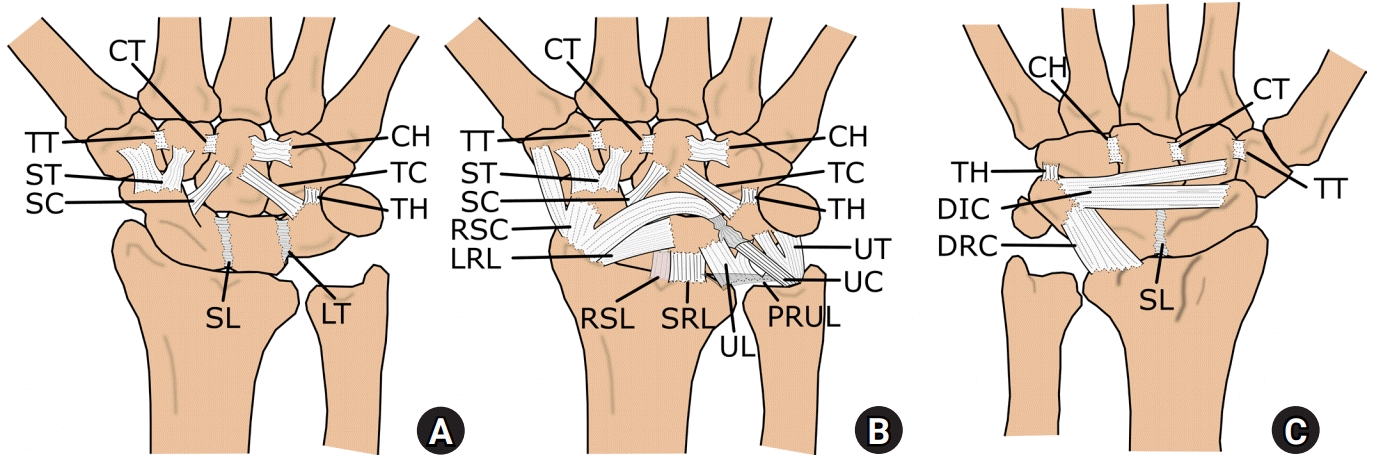

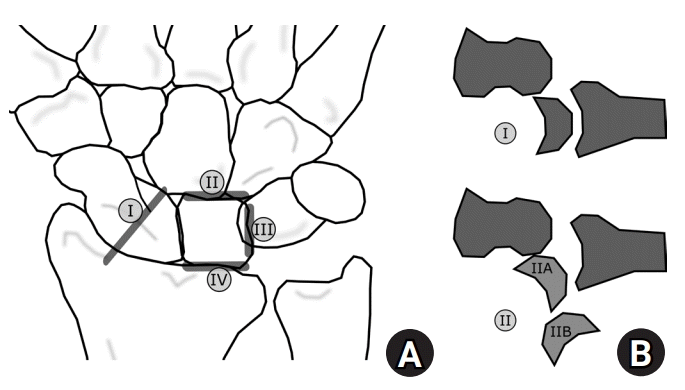
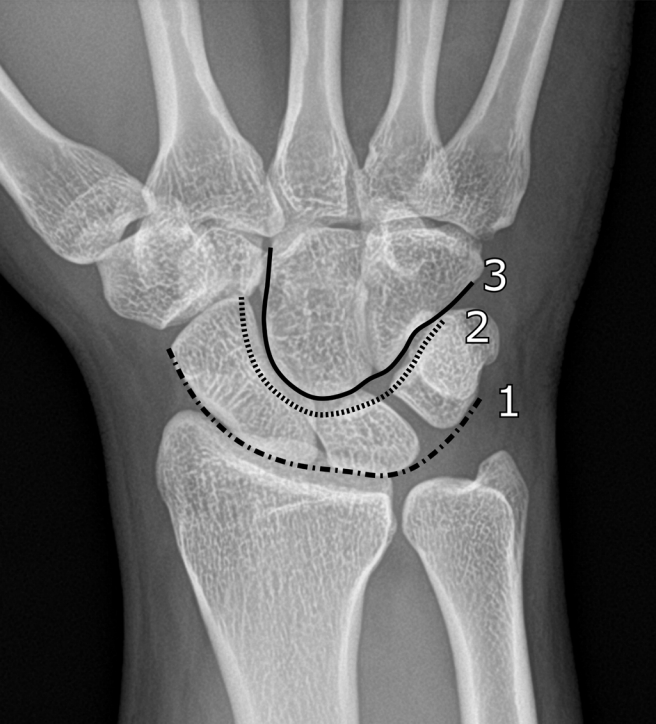
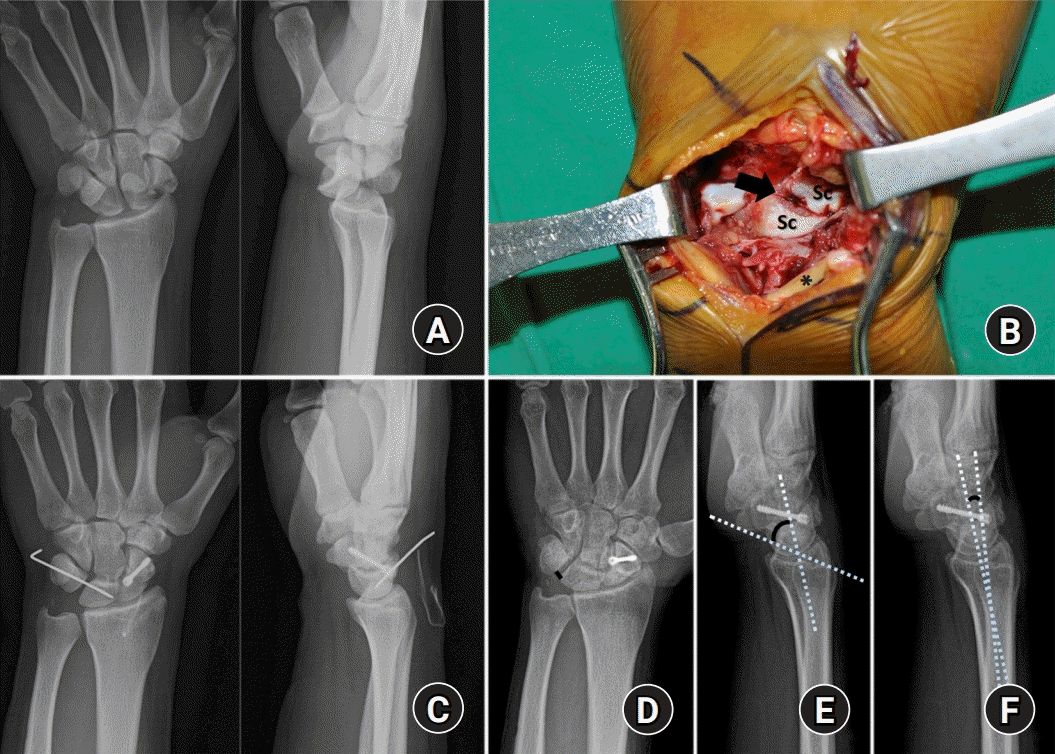
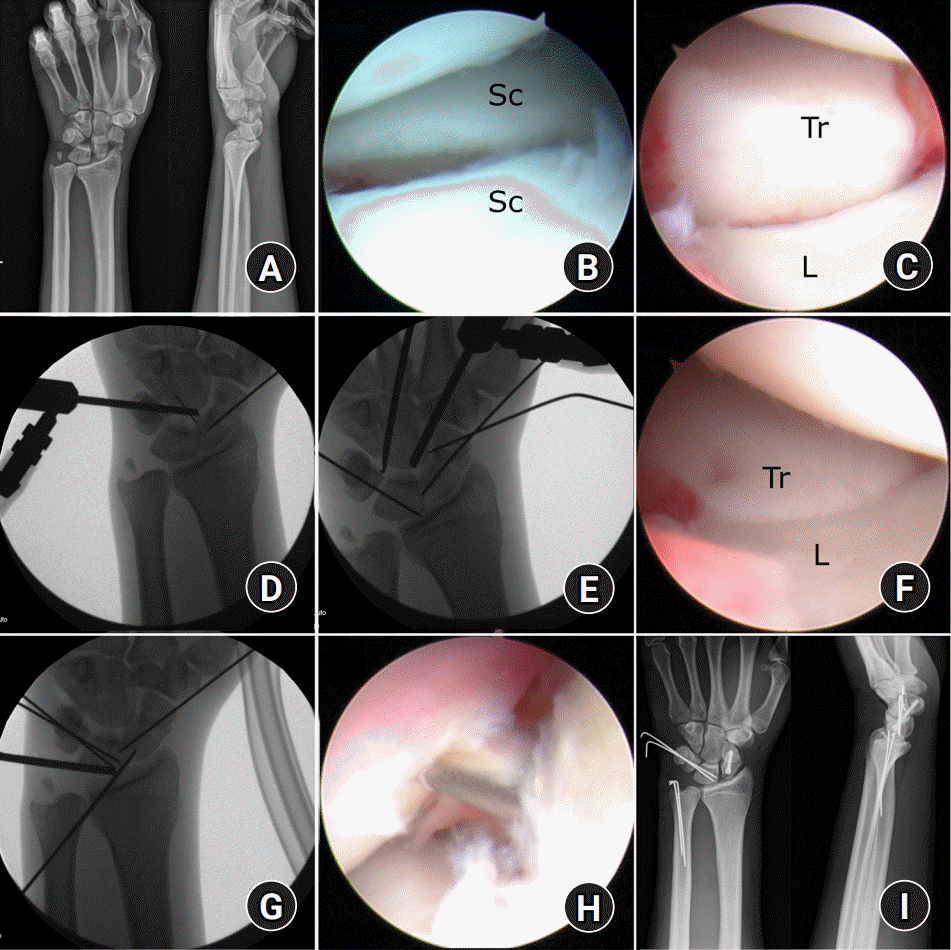
 XML Download
XML Download